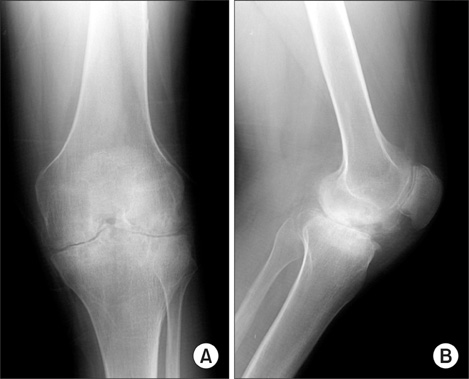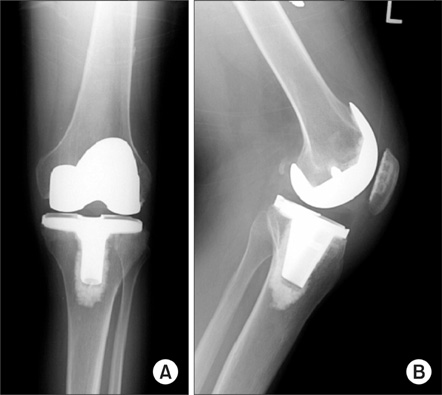Clin Orthop Surg.
2012 Jun;4(2):121-128. 10.4055/cios.2012.4.2.121.
Total Knee Arthroplasty in Hemophiliacs: Gains in Range of Motion Realized beyond Twelve Months Postoperatively
- Affiliations
-
- 1Department of Orthopaedic Surgery, Hospital of the University of Pennsylvania, Philadelphia, PA, USA. atul.kamath@uphs.upenn.edu
- 2Department of Physical Therapy, Hospital of the University of Pennsylvania, Philadelphia, PA, USA.
- 3Department of Hematology & Oncology, Hospital of the University of Pennsylvania, Philadelphia, PA, USA.
- 4Department of Orthopaedic Surgery, Penn Presbyterian Medical Center, Philadelphia, PA, USA.
- KMID: 1383873
- DOI: http://doi.org/10.4055/cios.2012.4.2.121
Abstract
- BACKGROUND
Hemophiliacs have extrinsic tightness from quadriceps and flexion contractures. We sought to examine the effect of a focused physical therapy regimen geared to hemophilic total knee arthroplasty.
METHODS
Twenty-four knees undergoing intensive hemophiliac-specific physical therapy after total knee arthroplasty, at an average age of 46 years, were followed to an average 50 months.
RESULTS
For all patients, flexion contracture improved from -10.5 degrees preoperatively to -5.1 degrees at final follow-up (p = 0.02). Knees with preoperative flexion less than 90 degrees were compared to knees with preoperative flexion greater than 90 degrees. Patients with preoperative flexion less than 90 degrees experienced improved flexion (p = 0.02), along with improved arc range of motion (ROM) and decreased flexion contracture. For those patients with specific twelve-month and final follow-up data points, there was a significant gain in flexion between twelve months and final follow-up (p = 0.02).
CONCLUSIONS
Hemophiliacs with the poorest flexion benefited most from focused quadriceps stretching to a more functional length, with gains not usually seen in the osteoarthritic population. This data may challenge traditional views that ROM gains are not expected beyond 12-18 months.
MeSH Terms
-
Adult
Aged
Arthroplasty, Replacement, Knee/*methods
Female
Follow-Up Studies
Hemophilia A/complications/*physiopathology/*therapy
Humans
Joint Diseases/*blood/complications/surgery
Knee Joint/*physiopathology/surgery
Male
Middle Aged
*Physical Therapy Modalities
Range of Motion, Articular/physiology
Retrospective Studies
Treatment Outcome
Figure
Reference
-
1. Rodriguez-Merchan EC. Musculoskeletal complications of hemophilia. HSS J. 2010. 6(1):37–42.
Article2. Norian JM, Ries MD, Karp S, Hambleton J. Total knee arthroplasty in hemophilic arthropathy. J Bone Joint Surg Am. 2002. 84(7):1138–1141.
Article3. Siegel HJ, Luck JV Jr, Siegel ME, Quinones C. Phosphate-32 colloid radiosynovectomy in hemophilia: outcome of 125 procedures. Clin Orthop Relat Res. 2001. (392):409–417.4. Rodriguez-Merchan EC. Correction of fixed contractures during total knee arthroplasty in haemophiliacs. Haemophilia. 1999. 5:Suppl 1. 33–38.
Article5. Bae DK, Yoon KH, Kim HS, Song SJ. Total knee arthroplasty in hemophilic arthropathy of the knee. J Arthroplasty. 2005. 20(5):664–668.
Article6. Legroux-Gerot I, Strouk G, Parquet A, Goodemand J, Gougeon F, Duquesnoy B. Total knee arthroplasty in hemophilic arthropathy. Joint Bone Spine. 2003. 70(1):22–32.
Article7. Chiang CC, Chen PQ, Shen MC, Tsai W. Total knee arthroplasty for severe haemophilic arthropathy: long-term experience in Taiwan. Haemophilia. 2008. 14(4):828–834.
Article8. Figgie MP, Goldberg VM, Figgie HE 3rd, Heiple KG, Sobel M. Total knee arthroplasty for the treatment of chronic hemophilic arthropathy. Clin Orthop Relat Res. 1989. (248):98–107.9. De Kleijn P, Blamey G, Zourikian N, Dalzell R, Lobet S. Physiotherapy following elective orthopaedic procedures. Haemophilia. 2006. 12:Suppl 3. 108–112.
Article10. Mockford BJ, Thompson NW, Humphreys P, Beverland DE. Does a standard outpatient physiotherapy regime improve the range of knee motion after primary total knee arthroplasty? J Arthroplasty. 2008. 23(8):1110–1114.
Article11. Lachiewicz PF, Inglis AE, Insall JN, Sculco TP, Hilgartner MW, Bussel JB. Total knee arthroplasty in hemophilia. J Bone Joint Surg Am. 1985. 67(9):1361–1366.
Article12. Luck JV Jr, Kasper CK. Surgical management of advanced hemophilic arthropathy: an overview of 20 years' experience. Clin Orthop Relat Res. 1989. (242):60–82.13. Silva M, Luck JV Jr. Long-term results of primary total knee replacement in patients with hemophilia. J Bone Joint Surg Am. 2005. 87(1):85–91.
Article14. Goddard NJ, Rodriguez-Merchan EC, Wiedel JD. Total knee replacement in haemophilia. Haemophilia. 2002. 8(3):382–386.
Article15. Rodriguez-Merchan EC. Total knee replacement in haemophilic arthropathy. J Bone Joint Surg Br. 2007. 89(2):186–188.
Article16. Tamurian RM, Spencer EE, Wojtys EM. The role of arthroscopic synovectomy in the management of hemarthrosis in hemophilia patients: financial perspectives. Arthroscopy. 2002. 18(7):789–794.
Article17. Lobet S, Pendeville E, Dalzell R, et al. The role of physiotherapy after total knee arthroplasty in patients with haemophilia. Haemophilia. 2008. 14(5):989–998.
Article18. Atkins RM, Henderson NJ, Duthie RB. Joint contractures in the hemophilias. Clin Orthop Relat Res. 1987. (219):97–106.
Article19. Miller MD. Review of orthopaedics. 2004. 4th ed. Philadelphia: Saunders.20. Sheth DS, Oldfield D, Ambrose C, Clyburn T. Total knee arthroplasty in hemophilic arthropathy. J Arthroplasty. 2004. 19(1):56–60.
Article21. Naylor J, Harmer A, Fransen M, Crosbie J, Innes L. Status of physiotherapy rehabilitation after total knee replacement in Australia. Physiother Res Int. 2006. 11(1):35–47.
Article22. Defalque A, Lobet S, Pothen D, Hermans C, Poilvache P. Total knee arthroplasty in hemophilic arthroplasty: retrospective study of the functional improvement. In : Word Federation of Hemophilia 9th Musculoskeletal Congress; 2005 July 9-11; Istanbul, Turkey.23. Lizaur A, Marco L, Cebrian R. Preoperative factors influencing the range of movement after total knee arthroplasty for severe osteoarthritis. J Bone Joint Surg Br. 1997. 79(4):626–629.
Article24. Shoji H, Solomonow M, Yoshino S, D'Ambrosia R, Dabezies E. Factors affecting postoperative flexion in total knee arthroplasty. Orthopedics. 1990. 13(6):643–649.
Article25. Moffet H, Collet JP, Shapiro SH, Paradis G, Marquis F, Roy L. Effectiveness of intensive rehabilitation on functional ability and quality of life after first total knee arthroplasty: a single-blind randomized controlled trial. Arch Phys Med Rehabil. 2004. 85(4):546–556.
Article
- Full Text Links
- Actions
-
Cited
- CITED
-
- Close
- Share
- Similar articles
-
- Does contralateral knee range of motion predict postoperative knee range of motion after total knee arthroplasty?
- Total Knee Replacement Arthroplasty in Stiff or Ankylosed Knees
- The Total Knee Arthroplasty with PFC Sigma RP-F(R): Two Year Short-term Results
- TKA in Hemophilic Arthropathy of the Knee
- PCL Substituting Total Knee Replacement Arthroplasty



